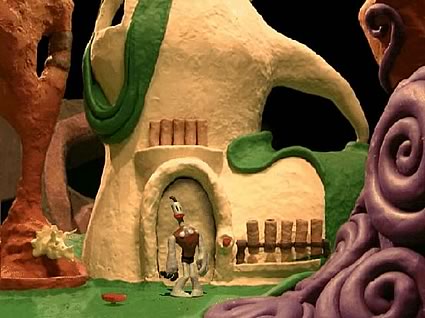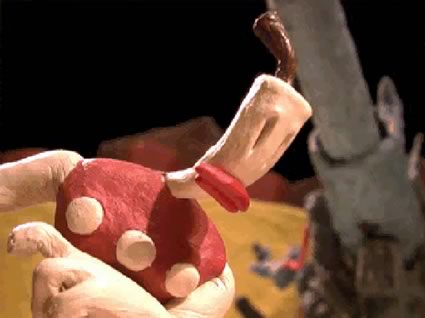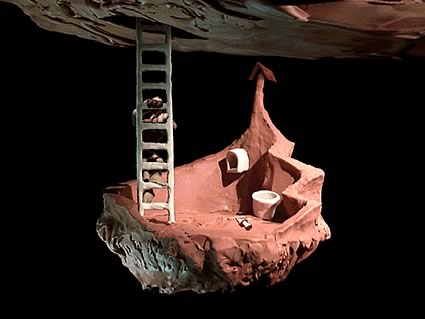Cletus: A History of Clay Games Part 2: The Neverhood
Welcome to Part 2 of the "History of Clay" blog posts by clay guru and creator of our latest game: Cletus Clay. (You can read Part 1 here) And now back to Anthony:
After seeing Trog in an arcade, and deciding that I wanted to try doing something similar one day when I was able to, I pretty much left the idea alone for a number of years. I continued to keep an eye out for other clay games, half-hoping to find one that really did the medium justice, and half-hoping that everyone would continue to leave it alone for me to stake my own claim on later. And for the most part, they did.
The nature of stop-motion animation makes it difficult to produce good-quality non-sequential animation of the kind needed for an interactive game character, and at that time, computer hardware was still not really powerful enough to deal with digital photo-editing easily anyway. Interplay did have the Clay Fighter series, and I do remember renting the first one out one weekend, but although the models looked decent, the animation wasn?t very good and the game didn?t really appeal to me.
And then in 1996, when I had just started my film degree, I saw a copy of The Neverhood in a shop, and just by looking at the box I could see that someone had finally gone and done it properly. I got myself a copy as soon as I could (for a student like me, that meant Christmas).

The Neverhood was the brainchild of Earthworm Jim creator Doug TenNapel, and with the backing of Dreamworks and the personal approval of Steven Spielberg behind him, his team were given the resources to make the clay game to end all clay games.
They bought their clay by the truckload and constructed an enormous clay set with it that filled the whole floor of a warehouse. It was an incredible display of clay opulence, captured in all its glory in 256 barely adequate colours on your home PC, which was about as good as we could expect in those days.
But 256 colours or not - just look at it! Woo!

The artists were first-rate cel animators, and the third-person scenes in the game were all animated in pencil first. These pencil animations were then recreated using clay (or foam latex) models.
It?s impressive and it looks very, very good even today. The intermittent cut-scenes, filmed as regular free-form stop-motion, have a bit more of the endearingly lumpy quality to them - they?re still pretty good, and some are also quite long and elaborate (and entertaining, I should add), but it?s the stuff that started out in pencil that really moves with style. The backgrounds, snapped from the aforementioned warehouse-sized set, are absolutely beautiful, and the whole thing is put together with great care and attention by a team of skilled and talented artists.
The result is a game that looks (and sounds) fantastic. In fact, I?d say that out of all the clay games released to date, The Neverhood is still the one that nails the style most perfectly - even in 256 colours.

But it?s not all good news. The game is a point-and-click adventure, and even though I?m a big fan of point-and-click adventures (Tim Schafer is one of my all-time favourite game designers) I?m afraid to say that The Neverhood is one of the weakest examples of the genre that I?ve ever played.
It all starts out well enough, with a couple of simple puzzles that suggests the game might be structured as a series of rooms filled with an increasingly bizarre collection of objects and machinery that must be used in a particular way to progress.
If only.
There are occasions when the game lives up to that promise, but for the most part it starts to go downhill once you get out of the first set of rooms.

After that, the game switches into first person perspective, and you get to explore that enormous set via a camera that they tracked through the whole thing along pre-defined paths. You control the camera by choosing which direction to take (and which clip to play) whenever it reaches a point where two or more paths meet.
It looks nice enough (despite the vicious compression on the video), and the set is undeniably cool, but soon the reality sets in that you?re going to spend more time in this game trudging around the place than solving proper puzzles. A disheartening number of the puzzles in the game simply involve traveling to some far-flung corner of the map to push a button or collect a code, before trekking all the way back again to push another button or punch the code in. And some of the other puzzles are as lazy as they come : a sliding block puzzle and a game of memory both feature ? the first is in a room where there?s a sliding block puzzle stuck on the wall, and the second is in a room where there?s a game of memory stuck on the wall. I mean, come on ? is it too much to expect a little more effort to integrate the puzzles into the game world?
This weakness is compounded by the extremely simple interface (just one button, and no functional inventory), which although admirably accessible just doesn?t offer the kind of flexibility and scope you find in a Lucasarts adventure (let alone a Sierra one). In The Neverhood, all you can do is click on things. Push buttons, write down codes, solve sliding-block puzzles. And walk, and walk, and walk, and walk.

The story serves well enough; a simple biblical parable that is abstracted sufficiently to avoid proselytising (fortunate, given TenNapel?s rather uh, fundamentalist religious convictions). I also think it may have been influenced by certain scenes in Will Vinton?s bizarre animated movie . It largely follows the less-is-more philosophy as the story is slowly revealed in small fragments.
Although there is a huge back-story written out on the walls of one very, very, very long room, it serves no practical purpose at all, and is one of many touches that show the abundance of creativity poured into this game. If only they knew how to design a good point-and-click adventure, dammit!
Regardless of its structural and design deficiencies, The Neverhood still stands as a landmark in video game art and creativity, and is well worth a look if you can abide its annoyingness.
Also worth noting: The Neverhood was ported to the Playstation for a Japan-only release, under the title Klaymen Klaymen (Klaymen being the name of the game?s protagonist). The port completely butchers one of the game?s best features (its excellent music) by restarting the music track every time the disk is accessed (which is often). I can?t begin to express how annoying this gets; it pretty much ruins the whole experience.

No Comments for this post yet...
Leave a comment:







